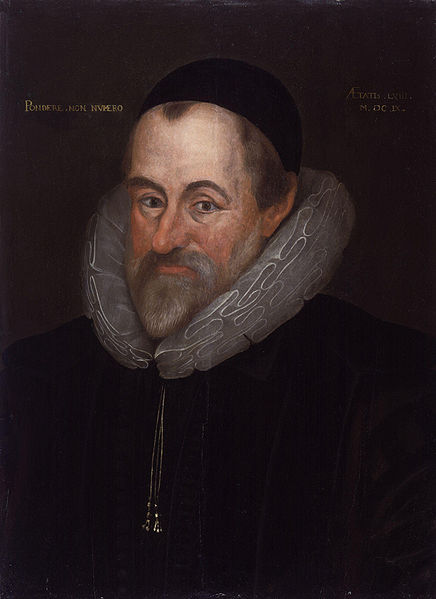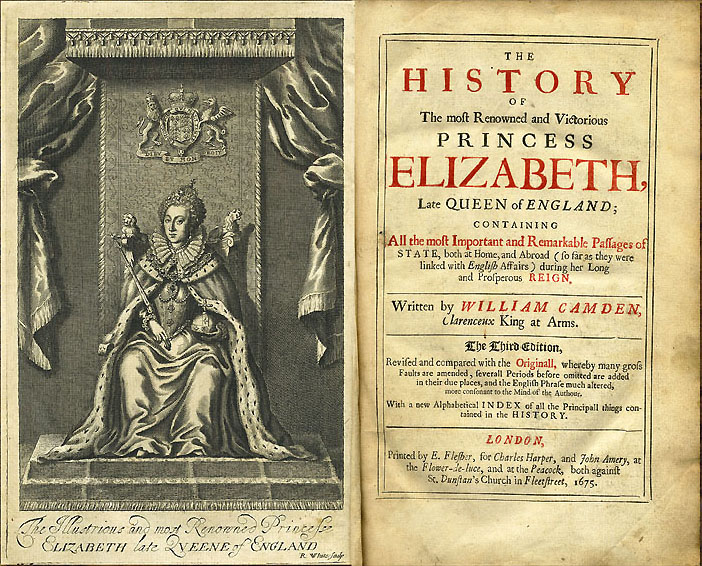<Back to Index>
- Historian William Camden, 1551
- Composer Alessandro Scarlatti, 1660
- German Fighter Pilot Manfred Albrecht von Richthofen (Red Baron), 1892
PAGE SPONSOR


William Camden (2 May 1551 – 9 November 1623) was an English antiquarian, historian, and officer of arms. He wrote the first topographical survey of the islands of Great Britain and Ireland and the first detailed historical account of the reign of Elizabeth I of England.
Camden was born in London. His father, Sampson Camden, was a member of The Worshipful Company of Painter-Stainers. He attended Christ's Hospital and St Paul's School, and in 1566 entered Oxford (Magdalen College, Broadgates Hall, and finally Christ Church). At Christ Church, he became acquainted with Philip Sidney, who encouraged Camden's antiquarian interests. He returned to London in 1571 without a degree. In 1575, he became Usher of Westminster School, a position that gave him the freedom to travel and pursue his antiquarian researches during school vacations.
In 1577, with the encouragement of Abraham Ortelius, Camden began his great work Britannia, a topographical and historical survey of all of Great Britain and Ireland. His stated intention was "to restore antiquity to Britaine, and Britaine to its antiquity." The first edition was published in 1586. The work, which was written in Latin, was very popular, going into seven editions by 1607. William Hole engraved title pages and some of the maps for the 1607 edition. The first English language translation, prepared by Philemon Holland (probably under Camden's direction) appeared in 1610.
Britannia is a county-by-county
description of Great Britain and Ireland. It is a work of chorography:
a
study that relates landscape, geography, antiquarianism, and history.
Rather than write a history, Camden wanted to describe in detail the
Great Britain of the present, and to show how the traces of the past
could be discerned in the existing landscape. By this method, he
produced the first coherent picture of Roman
Britain. He
continued to collect materials and to revise and expand Britannia throughout his life. He
drew on the published and unpublished work of John
Leland and William
Lambarde, among others, and received the assistance of a large
network of correspondents with similar interests. He did not simply
accept older authorities unquestioningly, but travelled throughout
Great Britain and looked at documents, sites, and artifacts for
himself, coming to his own conclusions based on first hand inspection
and knowledge of the available sources. His firsthand research set new
standards for the time. He even learned Welsh and Old
English for the
task. (Camden's tutor in Old English was Laurence
Nowell.) The resulting work is one of the great achievements of
sixteenth century scholarship. In 1593,
Camden became Headmaster of Westminster
School. He held the post for four years, but left when he was
appointed Clarenceux King
of Arms. By this time, he was a well-known and revered figure,
and the appointment was meant to free him from the labour of teaching
and to facilitate his research. The College
of
Arms at that
time was not only a centre of genealogical and heraldic study, but a centre of
antiquarian study as well. The appointment, however, roused the
jealousy of the herald Ralph
Brooke, who, in retaliation, published an attack on Britannia,
charging
Camden with inaccuracy and plagiarism. Camden successfully defended
himself against the charges in subsequent editions of the work. In 1597, Lord
Burghley suggested
that Camden write a history of Queen Elizabeth's reign. The degree of
Burghley's influence on the work is unclear, however; Camden only
specifically mentions Sir
John
Fortescue, Elizabeth's last Chancellor
of
the Exchequer, and Henry Cuffe, the Earl
of
Essex's secretary, as sources. Camden began his work in
1607. The first part of the Annales
Rerum
Gestarum Angliae et Hiberniae Regnate Elizabetha,
covering
the reign up to 1597, appeared in 1615. The second part was completed
in 1617, but was not published until 1625 (Leiden), and 1627 (London),
following Camden's death. The first translation into English appeared
in 1625. The Annales were not written in a
continuous narrative, but in the style of earlier annals, giving the
events of each year in a separate entry. Sometimes criticised as being
too favourably disposed towards Elizabeth and James
I, the Annales are one of the great works of English historiography and had a great impact on
the later image of the Elizabethan
age. Hugh
Trevor-Roper said
about them: "It is thanks to Camden that we ascribe to Queen Elizabeth
a consistent policy of via
media rather than
an inconsequent series of unresolved conflicts and paralysed
indecisions." In 1609,
Camden moved to Chislehurst in Kent. Though often in
ill health, he continued to work diligently. In 1622, he founded an
endowed lectureship in History at Oxford -- the first in the world -- which
continues to this day as the Camden
Chair
in Ancient History. That same year, he was struck with paralysis.
He
died in Chislehurst on 9 November 1623, and was buried at Westminster
Abbey. Camden
left his library to his closest friend, Sir Robert
Bruce
Cotton. His circle of friends and acquaintances included Lord
Burghley, Fulke
Greville, Philip
Sidney, Edmund
Spenser, John
Stow, John
Dee, Jacques
de
Thou and Ben
Jonson, who was Camden's student at Westminster and who dedicated
an early edition of Every Man in His Humour to him. Among
Camden's other works are a Greek
grammar, very popular at one time; Remaines of a Greater Worke,
Concerning Britaine (1605), a
collection of material gathered for Britannia but not included; the
official account of the trial of the Gunpowder
Plotters; and a catalogue of the epitaphs at Westminster Abbey.